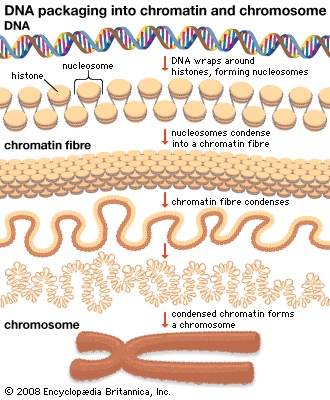chromosome
biology
the microscopic, threadlike part of the cell that carries hereditary information in the form of genes.
 The structure and location of chromosomes is one of the chief differences between the two basic types of cells: prokaryotic (prokaryote) cells and eukaryotic cells. Among organisms with prokaryotic cells (i.e., bacteria and blue-green algae), chromosomes consist entirely of deoxyribonucleic acid (DNA). The single chromosome of a prokaryotic cell is not enclosed within a nuclear membrane. Among all other organisms (i.e., the eukaryotes (eukaryote)), the chromosomes are contained in a membrane-bound cell nucleus. The chromosomes of a eukaryotic cell consist primarily of DNA attached to a protein core. They also contain ribonucleic acid (RNA). Among both prokaryotes and eukaryotes, the arrangement of components in the DNA molecules determines the genetic information. The remainder of this article pertains to eukaryotic chromosomes.
The structure and location of chromosomes is one of the chief differences between the two basic types of cells: prokaryotic (prokaryote) cells and eukaryotic cells. Among organisms with prokaryotic cells (i.e., bacteria and blue-green algae), chromosomes consist entirely of deoxyribonucleic acid (DNA). The single chromosome of a prokaryotic cell is not enclosed within a nuclear membrane. Among all other organisms (i.e., the eukaryotes (eukaryote)), the chromosomes are contained in a membrane-bound cell nucleus. The chromosomes of a eukaryotic cell consist primarily of DNA attached to a protein core. They also contain ribonucleic acid (RNA). Among both prokaryotes and eukaryotes, the arrangement of components in the DNA molecules determines the genetic information. The remainder of this article pertains to eukaryotic chromosomes.Every species has a characteristic number of chromosomes (chromosome number). In species that reproduce asexually, the chromosome number is the same in all the cells of the organism. Among sexually reproducing organisms, the number of chromosomes in the body (somatic) cells is diploid (2n; a pair of each chromosome), twice the haploid (1n) number found in the sex cells, or gametes (gamete). The haploid number is produced during meiosis (q.v.). During fertilization, two gametes combine to produce a zygote, a single cell with a diploid set of chromosomes. See also polyploidy.
Somatic cells reproduce by dividing, a process called mitosis (q.v.). Between cell divisions the genetic material (chromatin) is diffused throughout the nucleus in a tangled network of filaments called chromonemata. These long filaments are formed from the uncoiled chromosomes and probably provide a large surface area, thereby facilitating DNA synthesis. During this phase, DNA duplicates itself in preparation for cell division.
At the onset of cell division, the chromonemata coil up and are surrounded by a protein sheath, forming a tiny rod, or chromosome. Each chromosome actually consists of a set of duplicate chromatids that are held together by the centromere. The centromere is the point of attachment to the spindle fibres (part of a structure that pulls the chromatids to opposite ends of the cell). During the middle stage in cell division, the centromere duplicates, and the chromatid pair separates; each chromatid becomes a separate chromosome at this point. The cell divides, and both of the daughter cells have a complete (diploid) set of chromosomes. The chromosomes uncoil in the new cells, again forming the diffuse network of filaments.
Among many organisms that have separate sexes, there are two basic types of chromosomes: sex chromosomes and autosomes. Autosomes control the inheritance of all the characteristics except the sex-linked ones, which are controlled by the sex chromosomes. Humans have 22 pairs of autosomes and one pair of sex chromosomes (see sex chromosome). All act in the same way during cell division. For information on sex-linked characteristics, see linkage group.
Chromosome breakage is the physical breakage of subunits of a chromosome. It is usually followed by reunion (frequently at a foreign site, resulting in a chromosome unlike the original). Breakage and reunion of homologous chromosomes during meiosis is the basis for the classical model of crossing over, which results in unexpected types of offspring of a mating.
- Richer, Jean
- Richet, Charles
- Richie Benaud
- Richier, Germaine
- Rich, Irene
- Rich, John
- Rich, Lady Penelope
- Richland
- Richler, Mordecai
- Richmond
- Richmond and Lennox, Frances Teresa Stuart, duchess of
- Richmond, Charles Lennox, 1st Duke of, 1st Duke of Lennox, Earl of March, Earl of Darnley, Baron of Settrington, Lord of Torboultoun
- Richmond, Charles Lennox, 3rd duke of, 3rd duke of Lennox, duc d'Aubigny, earl of March, earl of Darnley, baron of Settrington, lord of Torboultoun
- Richmond, Henry Wilmot, 1st earl of
- Richmond Lattimore
- Richmond River
- Richmondshire
- Richmond, University of
- Richmond upon Thames
- Rich, Richard Rich, 1st Baron
- Richter, Burton
- Richter, Charles F.
- Richter, Conrad Michael
- Richter, Curt Paul
- Richter, Gerhard